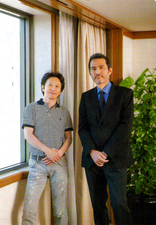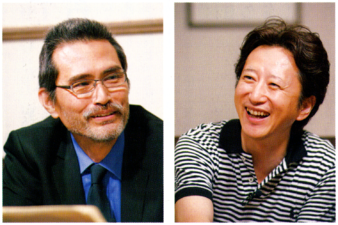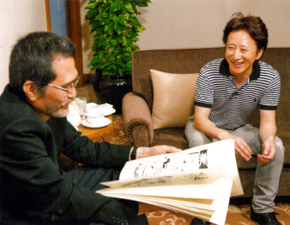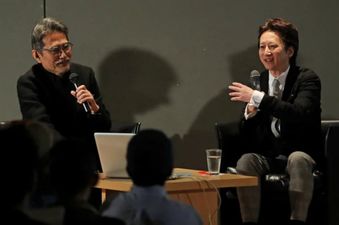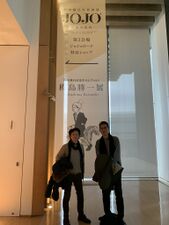Ryosuke Kabashima
Ryosuke Kabashima (椛島良介, Kabashima Ryōsuke) was Hirohiko Araki's first editor and was largely responsible for his growth during the first ten years of Araki's professional career as a manga artist. His involvement would last from 1979 up until the finale of Stardust Crusaders in 1992.[3]
Kabashima is currently the head director of Shueisha's Shinsho editorial department,[3] but was originally an editor for Weekly Shōnen Jump up until September 2013. He is the grandson of Katsuishi Kabashima.
History
Prior to becoming an editor, Kabashima had studied archaeology and the History of the Western World.[4]
Meeting Araki
Kabashima was a relatively new editor when he first met Araki back in 1979. At the time, Araki's sent-in manga submissions were constantly rejected by various publishing companies, spurring him to go straight to Shueisha's editorial building to get some answers. It was around noon when Araki arrived and Kabashima, who was coincidently walking to the receptionist desk, ended up being the first to critique Araki's submission. According to Araki, Kabashima was extremely severe and pointed out each of Araki's technical faults (from having forgotten to erase pen lines to leaking white-outs). However, he sensed potential in Araki's work and told him to fix his pages and apply for the upcoming Tezuka Awards. Araki's submission, Poker Under Arms, won the runner-up prize and would go on to be his first published manga.[1]
Before JoJo
Kabashima subsequently became Araki's editor and worked with him on his earliest publications. As a horror and suspense fan, he enjoyed Araki's early works and often encouraged him to avoid doing what was popular among other Jump titles. Kabashima also defended Araki's 1983 series, Cool Shock B.T., and advocated its publication despite the other editors' disapproval of its Japanese name (Devil Boy) and deviated content.[5]It was around this time that Kabashima began encouraging Araki to travel abroad, which resulted in Araki's first overseas trip from London to Paris.
After B.T.'s serialization, Kabashima assisted Araki in renting a Tokyo apartment for a year. By living in the same city as Shueisha's editorial building, Araki no longer needed to commute every week and could focus more time on his next series, Baoh: The Visitor. During its short run, Kabashima was adamant about improving Araki's weekly schedule management, which included getting enough sleep and taking breaks on Fridays and Saturdays. Kabashima set aside these off-days, particularly so Araki could gather material through experiencing other media. It was thanks to this schedule that Araki could go to the movie theatres almost every week, sometimes with Kabashima tagging along.
JoJo's Bizarre Adventure
The name "JoJo" was derived at a Denny's where Kabashima and Araki had their first meeting pertaining to the series.[3] The two had decided on "Jonathan" as the series' protagonist, however, Araki also wanted the initials to match in a way similar to the American filmmaker, Steven Spielberg (S.S). They eventually landed on the name, "Jonathan Joestar" (J.J) and thus the nickname "JoJo" was born.[6] Their subsequent meetings would ironically be at a "Jonathan's Family Restaurant" as it was closer to Araki's workplace.
Kabashima was the one who suggested that Stardust Crusaders happened in Egypt. Kabashima liked Egypt and proposed to feature it. Araki was reluctant at first and the two went together in Egypt.[7]
Gallery
References
- ↑ 1.0 1.1 Interview Archive, Tokai Lecture 06/2006
- ↑ JOJOnicle: Long Interview with Ryosuke Kabashima
- ↑ 3.0 3.1 3.2 JOJOVELLER: History 1979-2013
- ↑ Hiroshi Goto, from "Jump, the golden age of manga"
- ↑ Hirohiko Araki's Manga Technique, Chapter 3, Resistance to a Devil Boy
- ↑ Interview with Hirohiko Araki - Phantom Blood (PS2) - 2006
- ↑ Interview Archive, Manga Heaven 06/25/2007
